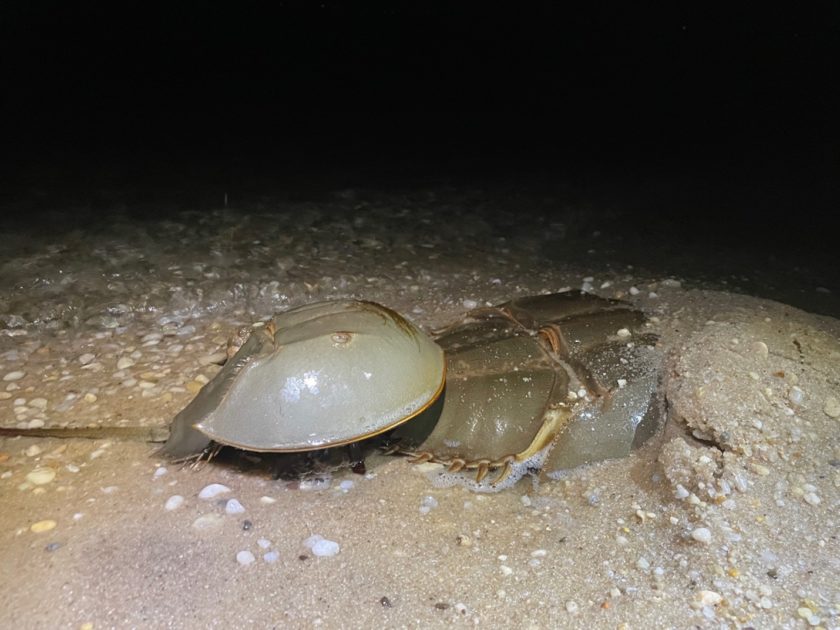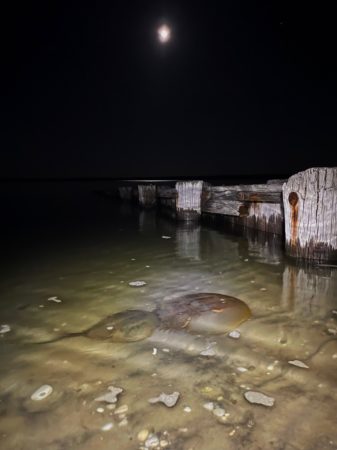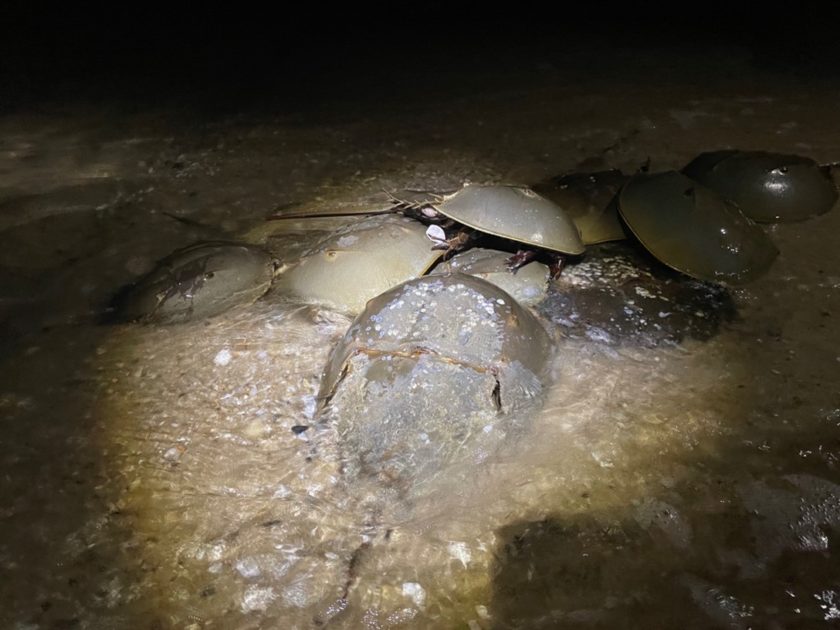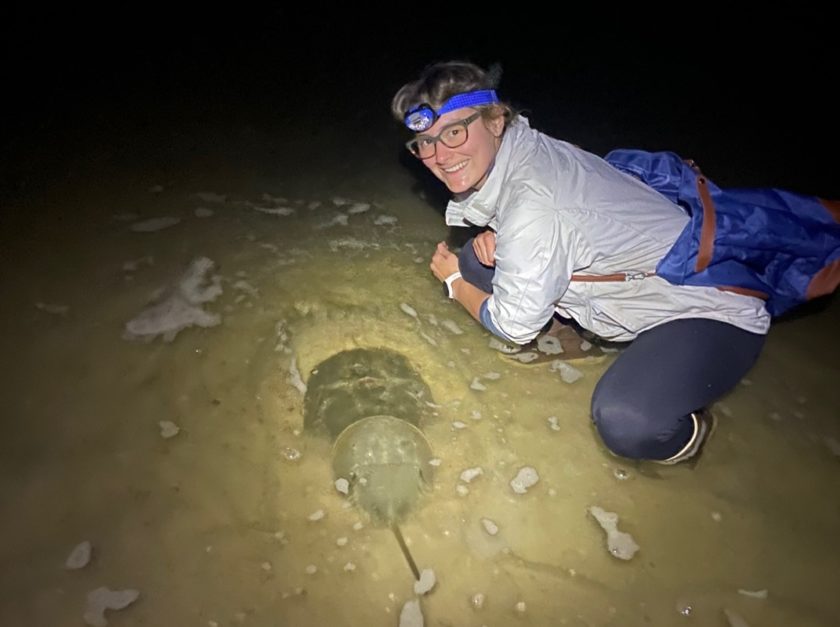Protecting & Restoring Long Island's Peconic Bays
Abigail Costigan, PEP Marine Conservation and Policy Fellow
I like organizing my schedule around the phases of the moon. It feels more sincere than the arbitrary ways we measure time. The moon fades in and out of fullness and its movements have real consequences. The tides respond, surging toward shore with varying intensity and height. On the new moon and full moon, the sun and moon’s gravitational pull align, pulling the ocean higher up on the shore. These are called spring tides, and I’m not the only one who has noticed their effect: long before I or even my species existed, horseshoe crabs have synchronized the most important ritual they take part in—reproduction—with the tides.

The extra height of the spring tide provides horseshoe crabs with an opportunity. If they lay their eggs at the edge of the shoreline during these extra high tides, they can reduce the number of predators that have access to them. However, as marine creatures, they will die if they get stuck on land and congregating at the edge of the water line is flirting with fate. They could get flipped over by a wave and dry out. Or they could be scooped up and thrown in the back of a pickup truck by fishermen. Some of the horseshoe crabs taken are used as bait for whelk and eels. Others are sold to biomedical companies’ in pursuit of their blood, which contains Limulus amebocyte lysate, (LAL). LAL reacts when exposed to gram negative bacteria, making it useful for testing drugs and devices before they come in contact with human blood. Some horseshoe crabs come to the beach to spawn, but are instead met with a seawall, or groin, making it impossible to dig their nests and lay their eggs, or fragmenting the shoreline so males have a harder time finding females.

In the Peconic Estuary, many property owners have installed these hardened shorelines in an attempt to beat sea level rise and increased storms due to climate change, replacing important coastal habitats like beaches, wetlands and eelgrass beds. It’s yet another version of paving paradise. For the horseshoe crab’s sake, I hope we go against what seems to be human nature and realize what we’ve got before it’s gone.
Like any good parent, horseshoe crabs want their offspring to have the best chances of survival, so they make the trip to the shore despite the risks. I try to meet them there. On the night of the Strawberry moon, the full moon of June, these dangers seem distant. The night is completely calm and almost cloudless, and the brightness of the moon affords better visibility than I’m accustomed to. Tiny human footprints are visible underwater; without any waves to clear the canvas, the evidence of a toddler pushing a toy truck around earlier that day is still intact. Eels emerge in the shallow water, wiggling up almost right onto the beach. Little sand fleas dominate the space between the lapping waves. Silversides smack the surface with their tails and catch the light from my flashlight. If I came with no expectations, it’d be a perfect night. The problem is, I’m here for horseshoe crabs—and I’ve been stood up.
I am confused. The spawning conditions are perfect. The water’s warm, the tide is high: where are they? Unfortunately, the problem of missing horseshoe crabs is not unique to me, or the Peconic Estuary. The American horseshoe crab’s population is considered vulnerable to extinction and in decline by the International Union for Conservation of Nature (IUCN). In New York state, their population status is considered poor by the Atlantic States Marine Fisheries Commission. Internationally, other species of horseshoe crabs are in even worse shape. The tri-spine horseshoe crab faces similar threats as its American counterpart, such as habitat loss, and over exploitation by biomedical companies, and unlike the American horseshoe crab, is also eaten by people. Due to these pressures, the tri-spine horseshoe crab is considered endangered. The other horseshoe crab species, the coastal horseshoe crab and mangrove horseshoe crab, are considered data deficient, as not enough is known to make a clear judgement on the state of their populations. To raise awareness for the grim state of the world’s horseshoe crabs, the IUCN named June 20th International Horseshoe Crab Day to increase awareness and improve horseshoe crab conservation.
The fate of horseshoe crabs is about more than the horseshoe crabs themselves; it affects whole coastal communities. When horseshoe crabs are extremely abundant, coastal biodiversity increases. According to horseshoe crab expert Dr. Jennifer Mattei, they should be a dominant species in coastal communities, like trees are in a forest. Without large populations, shore birds like red knots can’t eat their eggs, because they rely on horseshoe crabs to dig up nests and make eggs available. Blue crabs, mummichogs, sea bass and bluefish fry, as well as shorebirds, feed on their eggs. Sharks and leatherback sea turtles feed on adults. By walking around the bottom of the estuary, horseshoe crabs disturb the seafloor, kicking up nutrients and resuspending food particles. Communities of snails, sponges, bryozoans, mussels and make a living on their shells. The higher the horseshoe crab population, the healthier the ecosystem.
While it’s hard to gather data on historical abundance, past uses hint towards larger populations. In the 1800’s and early 1900’s, they were collected for use as fertilizer and livestock feed. Beaches used to be so full of them that people would complain of the stench. In his book, The View from Lazy Point, Carl Safina writes about seeing hundreds of spawning horseshoe crabs on one beach in the Peconic Estuary. This is in the early 2000s. While out there, he runs into a bayman out collecting horseshoe crabs to be sold as bait. Now, less than twenty years later, at a nearby beach I see just a lone pair.
Deborah Cramer had it right in her book The Narrow Edge, where she writes “We so easily settle for the diminished world around us, a world that, in terms of the richness and abundance of plant and animal life, may be a mere 10 percent of what it once was. Unaware of what we have lost, we can’t imagine what we might restore, and instead, we argue over how many of the scraps we might still take.”

Ideas of what we’ve lost and how we might get it back occupy my mind as I comb the beach for horseshoe crabs. I think back to May, to the excitement of finding over seventy horseshoe crabs on one beach, congregating to spawn. As happy as I am whenever I find clusters of horseshoe crabs, the idea that I’m settling for scraps haunts me. It’s not just about horseshoe crabs, or coastal biodiversity. It’s that I know we can do better. We can create living shorelines that reduce damage during storms but also provide habitat. We can use bait to catch eels and whelk that requires fewer horseshoe crabs to make (or just simply catch fewer eels and whelk, as both species have low populations as well). Just as the biomedical industry switched from using rabbits to horseshoe crabs to test for impurities in biomedical devices, we can switch to a synthetic alternative, recombinant factor C. A world with more horseshoe crabs is possible—and worth the effort.

Sign up for News, Events and Information straight to your inbox.
